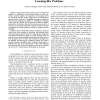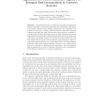325 search results - page 2 / 65 » Evolvable network architectures: what can we learn from biol... |
HICSS
2008
IEEE
14 years 1 months ago
2008
IEEE
Many peer-to-peer (P2P) networks have been widely used for file sharing. A peer acts both as a content provider and a consumer, and is granted autonomy to decide what content, wit...
SIGMOD
2008
ACM
14 years 7 months ago
2008
ACM
Online Transaction Processing (OLTP) databases include a suite of features -- disk-resident B-trees and heap files, locking-based concurrency control, support for multi-threading ...
CEC
2007
IEEE
14 years 1 months ago
2007
IEEE
— Environments with varying reward contingencies constitute a challenge to many living creatures. In such conditions, animals capable of adaptation and learning derive an advanta...
ARCS
2005
Springer
14 years 29 days ago
2005
Springer
This paper examines how methods inspired by biological processes can be applied to the design of large-scale environment-aware sensor networks. Our ultimate goal are systems conta...
PPSN
2004
Springer
14 years 23 days ago
2004
Springer
A scalable architecture to facilitate emergent (self-organized) task decomposition using neural networks and evolutionary algorithms is presented. Various control system architectu...




